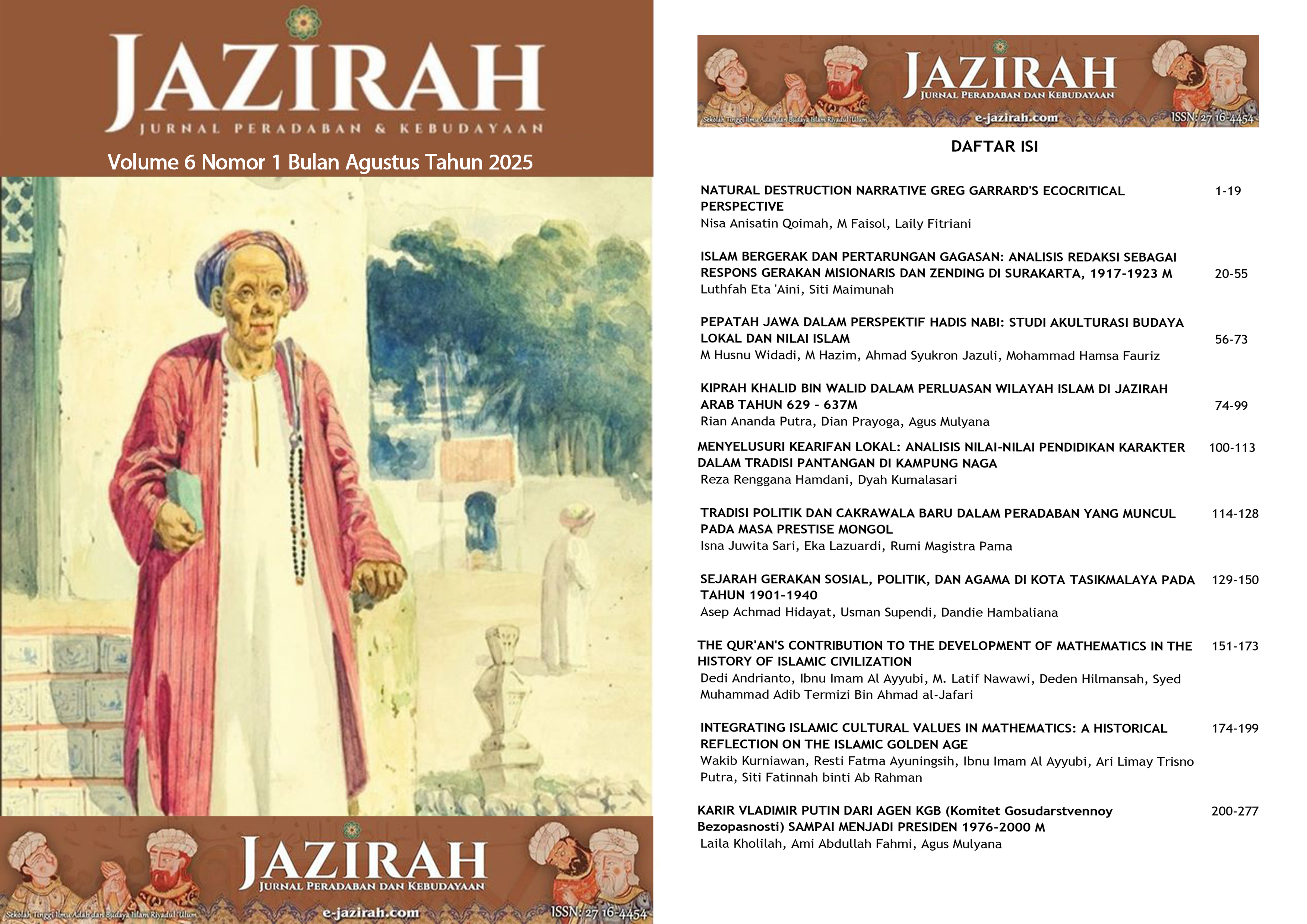MENYELUSURI KEARIFAN LOKAL: ANALISIS NILAI-NILAI PENDIDIKAN KARAKTER DALAM TRADISI PANTANGAN DI KAMPUNG NAGA
Main Article Content
Abstract
This research aims to examine the values of character education contained in the tradition of taboo in Naga Village, Tasikmalaya, as part of oral cultural heritage and local wisdom. The tradition of taboo is not only a traditional taboo, but a value system that shapes the character of society through the internalization of noble values such as religiosity, responsibility, simplicity, respect for ancestors, and social ethics. This study uses a qualitative approach with the Colaizzi phenomenological method, to reveal the deep meaning of people's experiences in undergoing abstinence. Data was obtained through in-depth interviews, observations, and documentation of traditional leaders and residents of Naga Village. The results of the study show that taboos in Kampung Naga function as a medium for character education that grows naturally, inseparable from daily life and the local cultural context. This tradition reflects the three dimensions of character education according to Lickona: moral knowing, moral feeling, and moral action. This research reinforces the idea that character education can not only be built through formal institutions, but also through the inheritance of local values that are full of symbolic and spiritual meaning. This study recommends the integration of local wisdom into education policies as a strategic step to face the challenges of globalization.
Downloads
Article Details
Authors who publish with this journal agree to the following terms:
- Copyright on any article is retained by the author(s).
- The author grants the journal, right of first publication with the work simultaneously licensed under a Creative Commons Attribution License that allows others to share the work with an acknowledgment of the work’s authorship and initial publication in this journal.
- Authors are able to enter into separate, additional contractual arrangements for the non-exclusive distribution of the journal’s published version of the work (e.g., post it to an institutional repository or publish it in a book), with an acknowledgment of its initial publication in this journal.
- Authors are permitted and encouraged to post their work online (e.g., in institutional repositories or on their website) prior to and during the submission process, as it can lead to productive exchanges, as well as earlier and greater citation of published work.
- The article and any associated published material is distributed under the Creative Commons Attribution-ShareAlike 4.0 International License
References
Banks, J. A. 2001. Cultural Diversity and Education: Foundations, Curriculum, and Teaching (4th ed.). Boston: Allyn & Bacon.
Colaizzi, P. F. 1978. Psychological research as the phenomenologist views it. Dalam R. S. Valle & M. King (Ed.), Existential phenomenological alternatives for psychology. New York: Oxford University Press.
Creswell, Jhon W., and Timothy C. Guetterman. 2019. EDUCATIONAL RESEARCH Planning, Conducting, and Evaluating Qualitative and Quantitative Reasearch. Sixth Edit. New Jersey: Pearson.
Darwis, Robi. 2017. “TRADISI NGARUWAT BUMI DALAM KEHIDUPAN MASYARAKAT (Studi Deskriptif Kampung Cihideung Girang Desa Sukakerti Kecamatan Cisalak Kabupaten Subang).” Jurnal Studi Agama-Agama Dan Lintas Budaya 2 (1): 75–83. 10.15575/rjsalb.v2i1.2361.
Endraswara, Suwardi. 2013. Folklor Nusantara. Yogyakarta: Ombak.
Geertz, C. 1973. The Interpretation of Cultures. New York: Basic Books.
Hutomo. 2013. Mutiara Yang Terlupakan. Jawa Timur: Himpunan Sarjana Kesusastraan Indonesia.
Ismanto. 2020. “TINJAUAN ASPEK-ASPEK KAMPUNG NAGA.” Al-Tsaqafa: Jurnal Ilmiah Peradaban Islam 17 (2): 213–20. 10.15575/al-tsaqafa.v17i2.10454.
Kemendiknas. 2010. Seri Pendidikan Karakter: Teori Dan Aplikasinya. Jakarta: Kemendiknas RI.
Kementerian Pendidikan Nasional. 2010. Pengembangan Pendidikan Budaya dan Karakter Bangsa: Pedoman Sekolah. Jakarta: Pusat Kurikulum dan Perbukuan.
Koentjaraningrat. 2009. Pengantar ilmu antropologi. Jakarta: Rineka Cipta.
Kurniawan, Machful Indra. 2015. “Tri Pusat Pendidikan Sebagai Sarana Pendidikan Karakter Anak Sekolah Dasar.” Pedagogia: Jurnal Pendidikan 4 (1). https://doi.org/https://doi.org/10.21070/pedagogia.v4i1.71.
Laksana, Sigit Dwi. 2015. “Urgensi Pendidikan Karakter Bangsa Di Sekolah.” Muaddib: Studi Kependidikan Dan Keislaman 5 (1): 167–83.
Lickona, T. 1991. Educating for Character: How Our Schools Can Teach Respect and Responsibility. New York: Bantam Books.
Mulyasa, H. E. 2013. Manajemen Pendidikan Karakter. Jakarta: Bumi Aksara.
Munifah, Siti. 2021. “Nilai Kultural Dan Pendidikan Dalam Tradisi Jawa Bubakan.” Jurnal Bahasa Dan Sastra 8 (2): 113–19.
Nashihin, Husna, and Puteri Anggita Dewi. 2019. “TRADISI ISLAM NUSANTARA PERSPEKTIF PENDIDIKAN MULTIKULTURAL.” Islam Nusantara 3 (2). https://jurnalnu.com/index.php/as/article/view/135.
Ningrum, Epon. 2012. “Dinamika Masyarakat Tradisional Kampung Nagadi Kabupaten Tasikmalaya.” MIMBAR 28 (1): 47–54.
Nurgiyantoro, B. (2011). Pendidikan Karakter dalam Cerita Rakyat. Yogyakarta: Gadjah Mada University Press.
Qodariah, Lelly, and Laely Armiyati. 2013. “Nilai-Nilai Kearifan Lokal Masyarakat Adat Kampung Naga Sebagai Alternatif Sumber Belajar.” SOCIA 10 (1): 10–20.
Rohmadi, Ridho Wildan, Ahmad Karim Maulana, and Suprapto. 2021. “Representasi Tradisi Lisan Dalam Tradisi Jawa Methik Pari Dan Gejug Lesung.” DIWANGKARA: Jurnal Pendidikan, Bahasa, Sastra Dan Budaya Jawa 1 (1): 36–41.
Soekanto. 1993. Kamus Sosiolog. Jakarta: PT Raja Grafindo Persada.
Suryani, E. 2020. “Internalisasi Nilai Kearifan Lokal dalam Membentuk Karakter Masyarakat.” JISIP: Jurnal Ilmu Sosial dan Pendidikan, 4(2), 73–79.
Suyono, Ariyono, and Aminuddin Siregar. 1999. Kamus Antropologi. Jakarta: Akademika Pressindo.
Tilaar, H. A. R. 2002. Pendidikan, Kebudayaan dan Masyarakat Madani Indonesia. Bandung: Remaja Rosdakarya.
Wibowo, A. 2013. Pendidikan Karakter Berbasis Kearifan Lokal. Yogyakarta: Pustaka Pelajar.
Wiradimadja, Agung. 2018. “KEARIFAN LOKAL MASYARAKAT KAMPUNG NAGA SEBAGAI WUJUD MENJAGA ALAM DAN KONSERVASI BUDAYA SUNDA.” JSPH 3 (1): 1–8.

